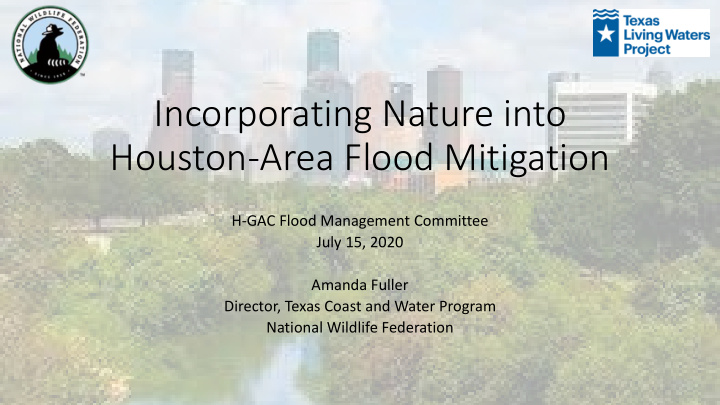



Incorporating Nature into Houston-Area Flood Mitigation H-GAC Flood Management Committee July 15, 2020 Amanda Fuller Director, Texas Coast and Water Program National Wildlife Federation
Objectives • Trends • “Natural infrastructure” – an umbrella term • Community benefits • Equity • Case studies • Next steps
Trends Growing interest in alternatives to conventional approaches Conventional “gray” infrastructure • Costly • Aging • Increasingly unreliable Healthy natural systems • Cost-effective • Adaptive to disturbances • Provide numerous co-benefits
Trends Texas General Land Office State Action Plan for CDBG-MIT
Trends FEMA’s Building Resilient Infrastructure and Communities (BRIC) Program
What is “natural infrastructure?” Natural systems that provide essential services and benefits to society • Clean air and water • Food • Natural resources • Fish and wildlife habitat • Recreational opportunities • Protection against natural hazards (i.e., “natural defenses”)
Performance of Natural Infrastructure • Globally, the estimated value of ecosystem services provided by natural systems, as a whole, ranges from $125–$145 trillion per year.2 In the United States alone, coastal habitats provide estimated benefits valued at over $100 billion annually. • Natural and nature-based approaches for hazard mitigation can be equally or more effective than conventional structural approaches, and they are often more cost-effective. • An acre of wetlands can typically store 1-1.5 million gallons of floodwaters. • In the Gulf region, every dollar spent on wetland restoration can yield more than seven dollars in flood reduction benefits. • According to the Greater Houston Area Flood Mitigation Consortium, where watersheds remain undeveloped acquisition of land along the bayous and creeks is a cost-effective flood mitigation tool.
What is “natural infrastructure?”
Community Benefits of Natural Infrastructure • Air quality improvements • Reduction in extreme heat • Enhanced water quality • Climate resilience • Cultural and spiritual fulfillment • Recreational opportunities • Greater quality of life • Environmental stewardship
Centering Equity Red areas represent the maximum observed flooding during Hurricane Harvey. Each shaded section of the map represents a census tract, colored according to its relative vulnerability. Darker areas are more vulnerable.
Centering Equity
Case Studies RiverSmart Homes in Washington, DC Northwest Resiliency Park in Hoboken, NJ
Case Studies Joe Rains Beach Living Shoreline Project, Cedar Key, Florida McFaddin Beach Shoreline Protection Project
Opportunities to Incorporate Nature in Proposals
Thank You Amanda Fuller Director, Texas Coast and Water Program National Wildlife Federation FullerA@nwf.org 512-610-7773
Recommend
More recommend